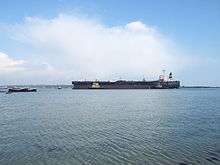Odessa–Brody pipeline
| Odessa–Brody pipeline (Sarmatia pipeline) | |
|---|---|
| Location | |
| Country | Ukraine, (Poland) |
| Coordinates | |
| General direction | south–north–west |
| From | Odessa |
| Passes through | Brody, Płock |
| To | Brody, (Gdańsk) |
| General information | |
| Type | oil |
| Partners | UkrTransNafta, PERN Przyjazn SA, GOGC and the SOCAR, Klaipedos Nafta |
| Operator | UkrTransNafta |
| Commissioned | 2002 |
| Technical information | |
| Length | 674 km (419 mi) |
The Odessa–Brody pipeline (also known as Sarmatia pipeline) is a crude oil pipeline between the Ukrainian cities Odessa at the Black Sea, and Brody near the Ukrainian-Polish border. There are plans to expand the pipeline to Płock, and furthermore to Gdańsk in Poland. The pipeline is operated by UkrTransNafta, Ukraine's state-owned oil pipeline company.
History
The usage and direction of Odessa–Brody pipeline is considered to be of considerable geopolitical significance and has thus been the subject of both political disagreement and international pressure. The pipeline was originally intended to reach Gdańsk in order to transfer oil from the Caspian Sea (mainly from Kazakhstan) to the Polish Baltic Sea port and from there to the rest of Europe. The Pivdenny maritime terminal in Odessa and the pipeline between Odessa and Brody was built in May 2002 by Ukrnaftogazbud and operated by UkrTransNafta. UkrTransNafta was established to develop the commercial attractiveness of the Odessa–Brody pipeline. However, the pipeline remained unused until 2004.[1]
However, as sufficient capacities of oil supplies were not agreed, on 5 July 2004 the Ukrainian cabinet accepted proposal of Russian oil companies to reverse the pipeline flow, and thus making it transfer Russian oil southwards to the Black Sea and from there to Mediterranean destinations.[2] Currently the oil is shipped to the pipeline from the junction of the southern branch of Druzhba pipeline. On 24 March 2010, Ukraine's ambassador to Belarus proposed the pipeline begin operating in the averse direction in order to deliver Venezuelan crude to Belarusian refineries.[3]
Technical features

The current length of the pipeline is 674 kilometres (419 mi). The pipeline is operated by Ukrtransnafta, and the oil is shipped by TNK-BP. In 2006 TNK-BP pumped 3.42 million tons of oil through the pipeline. In 2007, this volume was exceeded as already during seven month in January–July almost 5.3 million tons of oil were pumped transported.[4]
Expansion
There are ongoing intentions to implement original project. On 13 May 2003, the European Commission declared the Odessa-Brody-Płock oil transportation project as a project of Pan-European interest and the trilateral EU-Ukraine-Poland Joint Expert Working Group (OBP JEWG) was created.[1]
In 2005, after the success of Viktor Yushchenko in the 2004 Ukrainian presidential election and the Orange Revolution, the new government has shown interest in using the pipeline in the direction originally intended, in order to transfer oil from the Caspian to Europe. The pipeline is planned to be prolonged to Płock in Poland, and from there through the existing branch off of the northern branch of Druzhba pipeline to Gdańsk. For developing this project, UkrTransNafta and Poland's pipeline operator PERN Przyjazn SA formed a joint venture Sarmatia sp.z.o.o. on 12 July 2004.[1]
On 27 October 2006 at the European Union-Ukraine summit, the President of Ukraine Viktor Yushchenko proposed to build an extension via Slovakia to Kralupy refinery in the Czech Republic. On 15 November 2006, the idea was supported by Ukraine's prime minister Viktor Yanukovych.[5]
On 11 May 2007 the presidents of Poland, Ukraine, Lithuania, Georgia and Azerbaijan, and the special envoy of the president of Kazakhstan agreed on the construction of a pipeline linking existing pipeline with Gdańsk.[6]
On 5 June 2007, at the Gdańsk meeting the intergovernmental working group of the project agreed to expand the composition of shareholders of Sarmatia sp.z.o.o. by companies from Azerbaijan, Georgia and Lithuania.[7] New shareholders probably will be Lithuania's Klaipedos Nafta, Georgian Oil and Gas Corporation (GOGC) and the State Oil Company of the Azerbaijani Republic (SOCAR). According to the agreements between the companies, Ukrtransnafta, PERN, SOCAR and GOGC will each own 24.75% of the shares, while Klaipedos Nafta will own 1% of shares.[8]
On 10 October 2007, the agreement forming a pipeline consortium was signed by the presidents of Poland, Ukraine, Lithuania, Georgia and Azerbaijan at the energy security conference in Vilnius.[9]
See also
- Baku-Tbilisi-Ceyhan pipeline
- Druzhba pipeline
- Trans-Balkan Pipeline
References
- 1 2 3 "Odessa-Brody-Plock Oil Transportation System". INOGATE Technical Secretariat. 2006-10-12. Archived from the original on July 18, 2011. Retrieved 2007-09-30.
- ↑ "Turkey asks Ukraine to give up reverse of Odessa-Brody oil pipeline". RIA Novosti. 2004-07-16. Retrieved 2008-02-02.
- ↑ "Ukraine Offers Odessa-Brody for Venezuelan Crude to Belarus". Oil&Gas Eurasia. Eurasia Press. 2010-03-25. Retrieved 2010-03-25.
- ↑ "TNK-BP reports on higher Odessa-Brody volume for 2007". Alexander's Gas & Oil Connections. 2007-08-09. Retrieved 2007-09-30.
- ↑ Socor, Vladimir (2006-11-16). "Kyiv changing ideas, mixing signals on Odessa-Brody oil pipeline". Eurasia Daily Monitor. The Jamestown Foundation. Retrieved 2007-09-30.
- ↑ "Six countries agree on oil pipeline bypassing Russia". Forbes. 2007-05-11. Retrieved 2007-09-30.
- ↑ "Communiqué on the Intergovernmental Working Group on energy issues meeting" (DOC). 2007-06-05. Retrieved 2007-09-30.
- ↑ "Ukrtransnafta Predicts That Odesa-Brody Pipeline Won't Start To Pump Oil Toward Brody Before 2011". Ukranews. 2007-07-17. Retrieved 2007-09-30.
- ↑ "Vilnius unveils Caspian pipe pact". Upstream Online. NHST Media Group. 2007-10-10. Retrieved 2007-10-13.
External links
| Wikimedia Commons has media related to Odessa–Brody pipeline. |